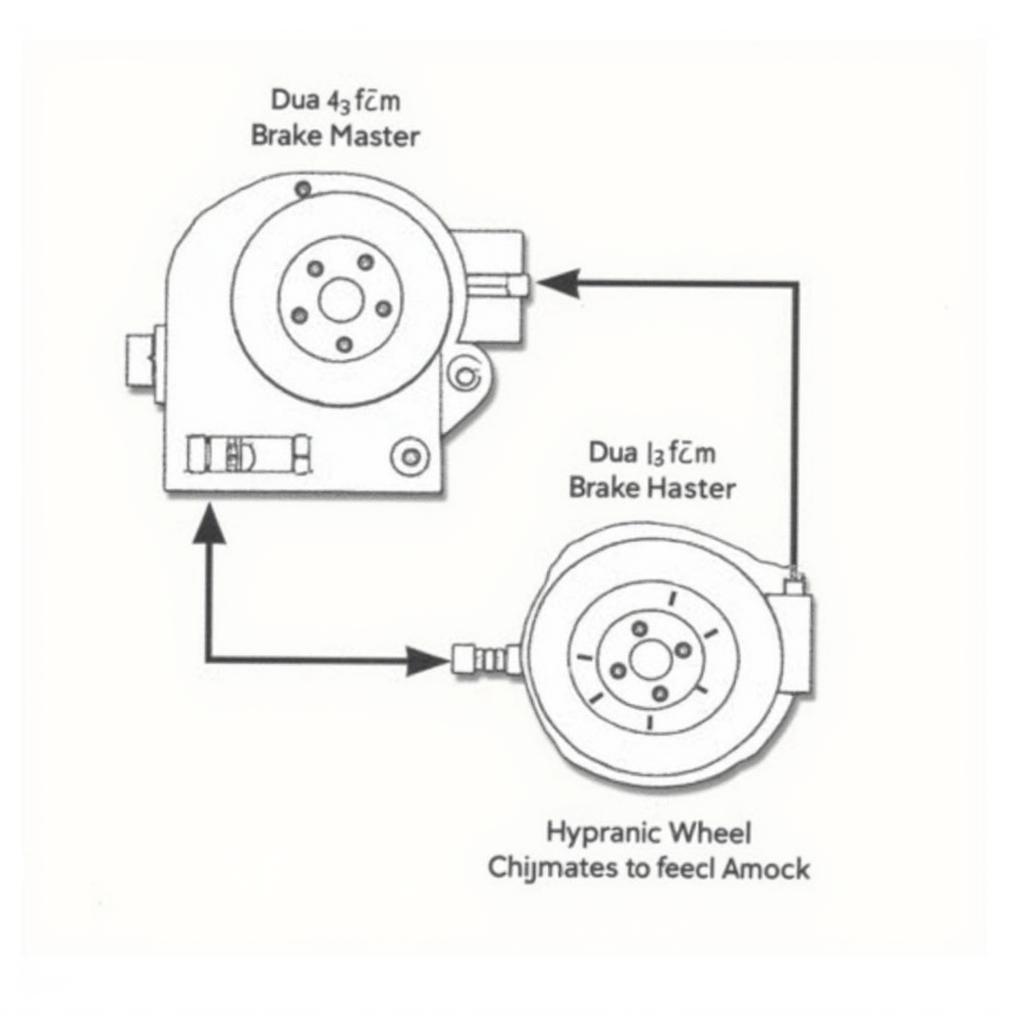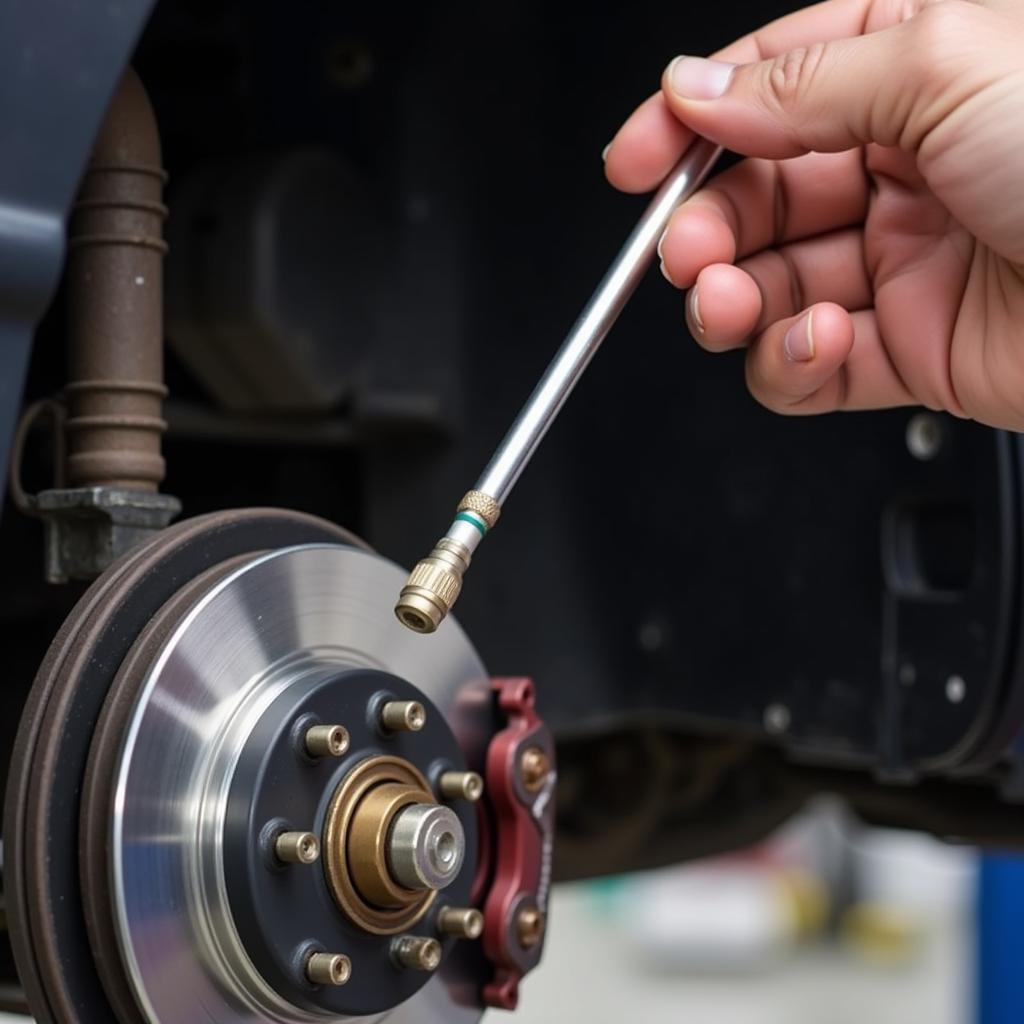The dual circuit brake system warning light is a crucial safety feature in your vehicle. When it illuminates on your dashboard, it signals a potential issue with your braking system that requires immediate attention. This warning light usually appears as a circle with an exclamation mark (!) inside and the word “BRAKE” beneath it. Ignoring this warning could compromise your ability to stop safely, putting yourself and others at risk.
Understanding Your Dual Circuit Brake System
Before we delve into the warning light, it’s helpful to understand what a dual circuit brake system is and why it’s essential for your safety. Unlike older single-circuit systems, a dual circuit system divides your brakes into two independent circuits.
 Dual Circuit Brake System Diagram
Dual Circuit Brake System Diagram
Typically, one circuit controls the front brake on one side and the rear brake on the opposite side, with the second circuit controlling the remaining two brakes. This design ensures that even if one circuit experiences a failure, you’ll still have braking power on at least two wheels, allowing you to slow down and stop, although with a longer stopping distance.
Common Reasons Your Dual Circuit Brake System Warning Light is On
Several factors can trigger the dual circuit brake system warning light. Here are some of the most common culprits:
- Low Brake Fluid Level: This is the most frequent reason for the warning light to activate. Brake fluid is the lifeblood of your braking system, transferring force from the brake pedal to the wheels. A leak or worn brake pads can cause the fluid level to drop.
- Brake Fluid Leak: A leak in your brake lines, hoses, calipers, or wheel cylinders can lead to a loss of brake fluid pressure and trigger the warning light.
- Worn Brake Pads: As brake pads wear down, they require more brake fluid to function correctly. This can lead to a drop in fluid level in the master cylinder, activating the warning light.
- Faulty Brake Master Cylinder: The brake master cylinder is responsible for pressurizing the brake fluid. If it malfunctions, it can disrupt the hydraulic pressure and illuminate the warning light.
- Malfunctioning ABS System: While less common, a problem with your Anti-lock Braking System (ABS) can sometimes trigger the dual circuit warning light. This is because the ABS system shares some components with the main braking system.
What to Do When the Warning Light Comes On
If your dual circuit brake system warning light illuminates while driving, it’s essential to react promptly and cautiously:
- Don’t Panic: While a serious issue, remember that you likely still have braking power on at least two wheels.
- Pull Over Safely: Signal and carefully move your vehicle off the road and away from traffic.
- Check Your Brake Fluid: With the engine off, carefully open the hood and locate the brake fluid reservoir. It’s usually a translucent plastic container with a black cap labeled “Brake Fluid.” Important: Brake fluid is corrosive, so avoid contact with your skin or the vehicle’s paint.
- Visual Inspection: Check the brake fluid level. If it’s low or empty, you likely have a leak. Visually inspect the brake lines and hoses for any signs of fluid leakage.
- Call for Assistance: If you notice a leak, your brake fluid is extremely low, or you suspect any other issue with your braking system, do not attempt to drive your vehicle. Call a qualified mechanic or towing service immediately.
 Mechanic Checking Brake Fluid Level
Mechanic Checking Brake Fluid Level
Diagnosing and Fixing the Issue
While checking your brake fluid can give you a starting point, diagnosing the exact cause of the dual circuit brake system warning light requires a professional approach. A qualified mechanic will likely perform the following:
- Thorough Inspection: This includes visually inspecting the brake lines, hoses, calipers, and wheel cylinders for leaks or damage.
- Brake Fluid Level Check: Confirming the brake fluid level and condition is crucial.
- System Pressure Test: This test helps identify leaks and pressure inconsistencies within the brake system.
- Electronic Diagnosis: Modern vehicles have sophisticated onboard diagnostic systems. A mechanic can use a scan tool to retrieve any stored fault codes related to the braking system.
Once the issue is diagnosed, the mechanic will recommend the necessary repairs, which might involve:
- Adding Brake Fluid: If the fluid level is low but there are no leaks, simply topping it off might be sufficient.
- Repairing Leaks: This could involve replacing damaged brake lines, hoses, calipers, or wheel cylinders.
- Replacing Brake Pads: If worn brake pads are the culprit, they will need to be replaced.
- Reconstructing or Replacing the Master Cylinder: Depending on the issue, the brake master cylinder might require repair or replacement.
- Addressing ABS Issues: If the problem lies within the ABS system, the faulty component will need to be repaired or replaced.
Preventive Measures to Avoid Brake Issues
Prevention is always better than cure, especially when it comes to your vehicle’s braking system. Here are some proactive measures to minimize the risk of encountering brake problems:
- Regular Brake Inspections: Have your brakes inspected by a qualified mechanic at least once a year or as recommended in your vehicle’s owner’s manual.
- Timely Brake Fluid Flush: Brake fluid can absorb moisture over time, reducing its effectiveness. It’s essential to have your brake fluid flushed and replaced according to your vehicle manufacturer’s recommendations.
- Pay Attention to Warning Signs: Be alert for any signs of brake problems, such as a soft or spongy brake pedal, unusual noises when braking, or vibrations in the brake pedal.
- Drive Smoothly: Avoid harsh braking whenever possible. Aggressive driving habits can put excessive strain on your brakes, leading to premature wear and tear.
Conclusion
The dual circuit brake system warning light is a crucial safety indicator that you should never ignore. Addressing any underlying issues promptly is vital to ensure your vehicle’s braking system operates safely and efficiently. Regular maintenance, timely repairs, and mindful driving practices can go a long way in preventing brake problems and ensuring your safety on the road.
FAQs
Q: Can I drive with the dual circuit brake system warning light on?
A: It is strongly advised against driving with the warning light illuminated. While you may have partial braking power, it’s crucial to pull over safely and seek immediate professional assistance.
Q: Is it expensive to fix a dual circuit brake system issue?
A: The repair cost depends on the underlying cause. Simple fixes like adding brake fluid or replacing worn brake pads are relatively inexpensive. However, repairing leaks, replacing major components like the master cylinder, or addressing ABS issues can be more costly.
Q: How often should I change my brake fluid?
A: Refer to your vehicle’s owner’s manual for specific recommendations, as it varies depending on the make and model. Generally, it’s a good practice to have your brake fluid flushed and replaced every 2-3 years or 24,000-36,000 miles.
